GOLF COURSE MANAGEMENT MAGAZINE - May 2001 |
 John’s Golf Course John’s Golf Course
A Montana family makes one son's golf dreams come true while healing from the loss of another.
by James Peacock
On a snowy day in spring 1999 a man came to my shop. He was seeking help after recently plunging headfirst into the golf industry. This gentleman is a player, architect, engineer, manager, director, owner, laborer, organizer, businessman, student, mechanic and, especially, a great dad. This man, Steve Espinoza, built a golf course at his home for his son, John, after John expressed an interest in playing golf. Usually I cringe when a person talks about building a backyard green, let alone an entire golf course, but I am excited for Steve and John. I offered them my help. After hearing the Espinozas' story, you may do the same.
Like most people attacking a backyard golf project, Steve did not understand the process or cost associated with producing and maintaining a golf course, but his standards were not high. He simply wanted a place where John could play. Originally he built a single green, which eventually ballooned to nine greens on a 10-hole layout (one green is used more than once). John's Golf Course in Eureka, Mont., now covers 10 acres with the longest hole at 320 yards and the shortest at 143.
Unlike other golf courses, John's GC charges no green fees. Because the golf course generates no income, it has no operating budget and ties up Steve's land, time, money and energy. John's GC is operated and maintained by a staff of two: Steve and John.
You might wonder if this guy is nuts. Why would he voluntarily subject himself to the effort of building and maintaining a golf course just so his son can play golf? The natural response is to say, "Take the kid to a real golf course; green fees are cheaper and easier." However, Steve built this golf course as an effort of love for his son. John has Down syndrome.
When John, a Special Olympian, expressed his interest in golf a few years ago, Steve thought, why not? He had John hitting balls in the yard but had strong reservations about driving John 60 miles to the Flathead Valley's nearest courses. Would these busy golf courses give John a poor reception? Steve knows that golfers are impatient with slow play, and he wanted John to have somewhere to play golf and enjoy the experience on his own terms.
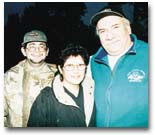
After the death of their oldest son, Mike, Juana and Steve Espinoza (center and right) encouraged their son John's (left) enthusiasm for golf, which Mike had also enjoyed. By 1999, Steve had built a 10-hole course on the family's property as John's love for the game grew.
Remembering Mike
Steve recalls the fateful day John announced his interest in golf. Steve and his wife, Juana, were outside when John approached them with his older brother's golf bag. He wanted to play. John's brother Mike was a golfer, and John idolized him. The golf bag, easily found in Mike's otherwise undisturbed room, was taken without permission. Mike, a local star athlete and regular all-American boy, had recently died at the age of 20 in a car accident, and the dispirited Espinozas were still mourning their loss. Their older son's death had rocked their faith, and they were still coming to terms with the tragedy.
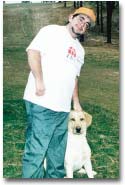
Here John and Zing are on one of the fairways on the course that bears John's name.
Even the Espinozas' dog, Zing, does his part for the family effort by retrieving errant golf shots.
With Mike's clubs, Steve, Juana and John started hitting balls in the yard. Steve says, "the hole in our hearts was there," but hitting balls in their yard "brought the three of us together." John's newfound interest gave the family a positive direction in which to channel their emotions. Building John's GC has helped the Espinoza family heal in their own way.
Steve still mourns his older son, but is now able to speak about Mike's death by celebrating his life. Describing Mike, Steve says, "he was what every old man wishes they were in their own youth." John, knowing his dad's pride in Mike, often asks if he is as good as Mike. Responding with equal pride in John, Steve tells him, "You are as good in your own way and are in so many ways better."
A love for the game
John's parents decided it was fine if he learned to play golf, but had no idea where it would lead the family. Golf was in John's blood the first time he swung a club. He was hitting balls in the yard nonstop, but that was not playing golf. The wooded yard was an unfavorable driving range, and John needed a bigger outlet.
Make no mistake, John is an enthusiastic golfer. We all know a golfer permanently fixed on the fairways, but compared to John, that person is a once-a-year hacker. He plays golf from sunup to sundown. "I like golf," John says. When asked about his first round this year, John says, "I got par on the first hole."
Considering John's passion for golf, Steve decided to build a green in the yard. With help from friends, advice from a local superintendent and seed donated from a local company, he made a start. "You know, that green is still my best green," Steve says. After the green was built, Steve thought it might be nice to have a fairway so John could hit longer shots to the green. A friend volunteered his bulldozer to clear trees and do the shaping. Then Steve started to have bigger thoughts.
'We do it with no money'
Steve began contacting courses around the country. On his fourth call, he found what he was looking for and then some. He spoke with a club in Las Vegas that had just purchased a fleet of equipment. They had a lot of old machinery, and Steve was willing to drive 1,500 miles to haul equipment back to Eureka. They gave the Espinozas a Greens Master 3000, a Toro walk-behind mower, a golf car and parts. They even took the time to sharpen and repair everything before Steve came. This gift equipped Steve with some of the essentials.
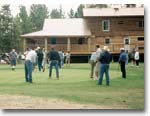
Contestants gather for the premier event at John's GC, an annual benefit tournament to send John, a Special Olympian, on a golf trip. The Espinoza home, which has yet to lose a window to a wild shot, is the center of the action on the 10-acre layout.
There seems to be no end to people's generosity. A country club in Los Angeles donated a large-deck mower, which is John's favorite machine (John proudly boasts the ability to mow all the roughs in four hours). Another course gave an LF-100 and extra reels. One facility gave him 100 sprinklers. A country club in Oregon contributed irrigation controllers. Steve could not afford solenoids for his new irrigation system, but after hearing his story, an irrigation company supplied solenoids for free. Irrigation pipe has been salvaged from many courses' demolition piles. Parts and equipment have come from all over.
In all, Steve estimates he and John have received donations of time, labor, equipment and materials exceeding $100,000.
 |
Many local Montana and Idaho courses have provided time, labor and materials as well. In all, Steve estimates he and John have received donations of time, labor, equipment and materials exceeding $100,000. When talking about everyone who has helped, Steve says, "There are so many people, I can't name them all. I have gotten some real positive feedback. It's a good feeling. People visit our house and say, 'Wow, you really do have a golf course.'" Steve occasionally needs to remind people that the first rule at the golf course is "We do it with no money!"
An all-inclusive club
Steve and John welcome everyone to John's GC. It is a place where kids and disabled people can play. This course exists without the formalities of the golf world, so you can play at any pace. You may hit as many shots as you want, and you might even enlist the Espinozas' dog, a yellow retriever named Zing, to retrieve poor shots. The Espinozas welcome help from visitors, and if you come, you will have no problem finding a golf partner. John is always ready to play, but good luck beating him: He's a ringer.
John plays the bulk of the course's annual rounds, but speaks of several community friends who golf with him. These friends are quick to help with maintenance projects as well. They have assisted with construction of tees, clearing brush and timber, installing irrigation and countless other tasks. Next season, they plan to add bunkers.
The Espinozas play host to one event every season, a benefit tourney that raises money to take John on a golf trip. Locals and friends enter, and it is the only time anyone pays to play the course. Promotional hats, shirts and jackets collected from businesses and dealers make up tee prizes given to every entrant. Individuals winning putting contests or hole prizes receive gift certificates for restaurants or golf passes to courses in the Flathead Valley area.
Steve does a lot of footwork to amass tournament prizes, and many businesses are extremely supportive. The tournament is not the U.S. Open, but it's just as important to the Espinozas. This event is one of the year's highlights for John, and his competitive nature comes out. Everyone is out to win, but John takes a special pride in defending his home course territory. But it's no home course advantage that allows John to walk away with prizes -- it's John's talent with a golf club. By the end of the tournament, he's sure to have several prizes in his possession.
The architect, Steve, designed the course with the flexibility to play to different greens from any tee whenever a change of scenery or new challenge is desired.
 |
Unique design
After talking to Steve and John, I visited John's course. Eureka is a typical small Montana town of 1,100. Located in the northwest corner of the state, it is about 10 miles from the Canadian border and 52 miles from the nearest golden-arched burger joint. The tall peaks of the Rocky Mountains surround this fine town that most people would enjoy calling home. I cannot think of a nicer place to build a golf course -- as long as revenue is unimportant.
John's GC impressed me with its simplicity. The Espinozas' house, built in the center of the 10 acres, is completely surrounded by the layout. The property is not wall-to-wall turf. Most of the course is cut native grasses, but Steve and John plan to continue establishing turf as they get more seed. Turfgrass, where planted, is healthy, and every year the course grows and develops a little more.
Making use of every available space, the intersecting fairways are reminiscent of Scotland's original golf courses. You do not necessarily have to play the holes in order; the architect, Steve, designed the course with the flexibility to play to different greens from any tee whenever a change of scenery or new challenge is desired. The fairways lack clear definition, which lends to playing the course a different way each round. Steve and John often bomb shots cross-country to whatever green tickles their fancy.
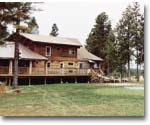
With donations from superintendents, suppliers and golf courses across the country, Steve has gathered equipment as well as a basic knowledge of how to maintain a golf course in his own backyard. donations
Unique hazards grace John's GC. You need confidence when attempting to strike a tee shot over the Espinozas' log home to reach one hole's green in regulation. Steve says the metal roof is hit frequently, but they have not lost any windows É yet. When I expressed my surprise that Juana lets them hit over the house, Steve flashed a funny grin that spoke volumes. He and John were both quick to point out that the only broken glass so far came from a street light behind the house struck by an errant ball Juana hit. A nearby basketball hoop attached to a tree had several holes blasted through it, attesting to other wild shots by unnamed players.
One-man show
Daily maintenance at John's GC is mostly a one-person job. John mows three times a week and enjoys his time operating the equipment. When he is not mowing, he is playing golf. The golf course would not exist without John's personal interest and commitment. Aside from simply grooming the course, John also makes some executive decisions regarding playing conditions. For this summer's tournament John decided to challenge golfers. He grew the collars long around the greens but mowed the rough short outside the collars. He said he wanted people to chip over the shaggy collars to hit greens. Because John is not fixed on traditional golf course management, expect the unexpected. If you don't like it, play somewhere else. I think John has the best job in the golf industry, and few find their work more rewarding than John finds his.
Steve makes the agronomic decisions at the course and is learning how to grow grass in his unique situation. His challenges differ from prototypical golf course undertakings. He has a couple of greens that are beautiful and in perfect shape, while other greens pose tests for both golfer and turf manager alike. Rutting deer chose one of his best greens as an arena for settling fights for herd dominance. The neighbor's grazing cattle created very rough areas in some putting surfaces, and a couple of greens have severe weed invasion where turf never established well. However, everything is playable and acceptable at a course with laid-back members and no rules.
This spring Steve is attempting to level and seed damaged areas and rebuild one of the greens. There is no pressure for perfect play, so Steve works at his own pace. When he has an idea, time or help, he goes to work. Resources are put to use when they become available. Working with no money, he does what he can.
How can you help the Espinozas? Frankly, Steve needs the same things superintendents need for their daily operations but on a smaller scale, and his membership does not care if it is new. Steve's biggest needs are seed and fertilizer. He would like to establish more turf and fill in thin areas. Most of Steve's turf is undernourished. Besides seed and fertilizer, he needs many other materials, supplies and management tools. If you inventory your facility, I am sure you will find resources for John's GC. Steve has done a wonderful thing for his son and local community, and I hope the individual courses and members represented in GCSAA will find a way to help them. Adding a twist to Steve's situation, he has received many items that he may never use that some of you might need. He has numerous LF-100 reels as well as various other parts. He generously wants materials he cannot use to go to someone who can. I caution people to avoid making Steve a collector and dealer of used junk; however, one man's junk is often another man's needed treasure.
Every time I have spoken with Steve, he is boiling over with excitement. Steve's pride in John and the enthusiasm this father and son share over John's GC is overwhelming and contagious. Every donation to the Espinoza family will more than pay for itself with the feeling you get from helping. Steve and John are inspirational. Steve's title in the golf industry has to fall under the category of "Great Dad." If you can help these remarkable people, call Steve's home at (406) 889-3685. Please try to remember the first rule at John's GC, "We do it with no money." However, I can assure you that your help is priceless.

James Peacock is superintendent at Meadow Lake Golf Resort in Columbia Falls, Mont., and a two-year GCSAA member. This article originally appeared in the Peaks and Prairies GCSA publication The Perfect Lie. |
|
GOLF COURSE MANAGEMENT MAGAZINE- November 2003 |
 BACK TO JOHN'S GOLF COURSE BACK TO JOHN'S GOLF COURSE
by James Peacock
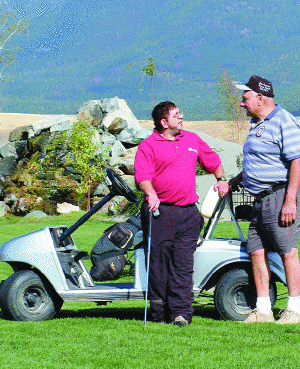
For John (left) and Steve Espinoza, life has changed since the tale of their homemade golf course in Eureka, Mont., was brought to national attention in 2001.
On June 24 at the 2003 World Special Olympics the official starter, Spanish golf great Seve Ballesteros, announced, "Representing the United States of America, next up, John Espinoza." With that, John Espinoza teed a ball on the first tee at Portmarnock Hotel and Golf Links in Dublin, Ireland. This realized yet another dream of a very special person, and added another chapter to an already amazing story.
The story spreads
A lot has happened since May 2001 when GCM featured a story about Steve and Juana Espinoza, their disabled son John, and the golf course they built in their backyard, John's Golf Course. Since the article's publication, the Espinozas have witnessed an amazing outpouring of generosity from the golf industry taking them around the country and even across the Atlantic Ocean. Unending nationwide donations have allowed for considerable growth of this family project. Better still, outside help has allowed John remarkable personal growth, new opportunities and has greatly improved his skills as a golfer.
John's GC has attracted considerable media attention. Since appearing in GCM two years ago, other national magazines, newspapers, local television news, radio broadcasts and even ESPN have covered the Espinozas' story. Every time the story is told, someone else wants to re-tell it. The ever-increasing media attention has given Steve better tools to try to acquire course supplies. Often donations to John's GC come from Steve's phone calls and footwork. After making a contact, he follows up by sending copies of articles, radio broadcasts and the ESPN feature. Steve says about 60 percent of his contacts turn out favorably. Most people want to help.
John's GC evolved from the Espinozas' wooded 10-acre yard surrounding their home in Eureka, Mont. Their treed property is now a modest golf course that gives John and other disabled individuals a comfortable outlet to golf without the pressures of a traditional facility. John's GC has very humble beginnings and is still not a fancy facility; but despite the lack of luster, John's GC might as well be Augusta National to its primary member and namesake. John is 25 and has Cornelia DeLange Syndrome (a form of Down Syndrome), but John has a passion for golf, and the father/son duo commits their free time to the golf course. Their love for this project shows.
If you didn't know anything about this facility, your first look at John's GC would probably reveal nothing remarkable. But after you are familiar with the Espinozas' story and see the sincere ear-to-ear smile on John's face when he launches a ball to a green, you understand what it is about. "It just keeps getting better," the ever-enthusiastic Steve says when asked about the course.
Father and son
John's GC, open to the public, does not charge greens fees, has no budget and relies totally on good will and donations. John's GC has no hired staff, but still needs maintenance, so John and Steve shoulder all the burden of daily upkeep.
John, with developmental disabilities, poor vision and dysfunctional hands, proves time and again he is capable of accepting responsibility and performing tasks above par. He operates all the donated equipment, mows and irrigates anywhere from 40 to 70 hours per week, and has no days off. John demonstrates his talents while working on the course. Recently Steve decided to enlarge a green. After five minutes of instruction and practice, John was operating the backhoe. Steve absolutely beams with pride when he talks about the way John handled the heavy equipment. "How proud can a dad be to see his son do it? Proud... oh man," Steve says. "You should have seen it. Father and son out there doing it!"
You might wonder why Steve would put his disabled son on a piece of heavy equipment to do delicate work. Remarkably, John is often the more physically capable of the two. On good days, Steve spends 5 percent of his day in a wheelchair. On bad days, the wheelchair consumes 75 percent of his day. Steve is a Vietnam veteran; every day, Steve, like many soldiers, gets a physical reminder of war.
Soldiering on
The Espinozas' are no strangers to adversity, and the golf course was built after a gut-wrenching family misfortune. The Espinozas' eldest son, Mike, died in a car accident at age 20. John, having idolized his older brother, wanted to be a golfer like Mike and started playing the game nine years ago. Steve nurtured John's interest by building a single small green in their backyard and then clearing some trees to make room for longer shots. John's GC has grown with John's desire to play the game. The course's development became therapy for the grieving family.
When asked about his wartime injuries, Steve doesn't linger on the details. He served as a machine gunner in the 1st Infantry Division. On an air assault 100 miles north of Saigon, he jumped from a helicopter into a rice paddy but landed on a boulder, breaking his ankle. While still recovering from the broken ankle, he was involved in another air assault. On this assault, he tightly laced his boot to brace his injured ankle and again jumped from a helicopter. This landing blew out his knee. Later, Steve injured his other knee while on patrol.
Steve gets a slightly distant and reflective look in his eyes when he talks about Oct. 29, 1967, the day he was shot in the chest during a firefight. Fortunately, he was wearing a flack jacket. His life is a credit to the effectiveness of that jacket; his permanent, severe back injury is a credit to that bullet's power.
Steve also lives with the nightmare of Agent Orange exposure, which caused internal bleeding. He and Juana often question if that might be responsible for John's disability or for the loss of Malia, their firstborn child and only daughter. Malia was born with a deformed heart and died in infancy. Doctors told them that the odds were low that they would have other children with problems. Then came Mike, born without disabilities and who would grow to become a local star athlete before his tragic death. John was their second wildcard.
Steve's injuries from service to his country are now arthritic, and he waits for spinal surgery. He could be bitter about his physical problems, but he isn't. He is proud of his military service and says, "Those are the things you live with when you have gone through combat."
Today, walking and standing aggravate Steve's injuries. However, he still possesses the same sense of duty and responsibility that cause a man with a broken ankle to jump from a helicopter. When he built this golf course for John he created another responsibility for himself and does what it takes to do the job. Last summer, while installing donated irrigation equipment, he was experiencing a long string of bad days. While leveling irrigation heads, Steve lay flat on a foam mat while Juana handed him tools. "It took time, and I got it done," he says. He says he can't manage his walk-behind mower on greens anymore, so John triplexes. "The only reason I get things done is John," Steve says. "John has picked up the slack." Still, Steve works hard, usually nearly 40 hours each week on their course and countless more hours laying the groundwork for the next potential donation.
Steve is very quick to acknowledge the huge amount of support he has found locally and throughout the country. Family and friends provide volunteer help and labor. Equipment and materials donations pour in from everywhere. Most people who hear the Espinozas' story want to be a part of it. "It gets people here," Steve says, pointing to his heart. "It makes you feel good, and it only keeps getting better."
Golden opportunities
The opportunities for John the golfer have escalated in a few short years. John's GC started because John wanted to play but was uncomfortable at local facilities, and Steve questioned the attitude of other golfers toward John. Now it seems that John is not only welcome anywhere, but also gets invitations to play around the world.
The first such invitation came shortly after the first article about John's GC appeared in GCM, when Steve received a call at home. The caller was Randy Allen, CGCS, director of golf for Burroughs and Chapin Co. Inc. in Myrtle Beach, S.C. Allen, a 25-year GCSAA member, had read the story in GCM and wanted to know how he could help. Not only did Allen give a generous donation of supplies and equipment, he also paid the expenses for the Espinozas to take a trip to Myrtle Beach. John enjoyed the golf at Grande Dunes, but says his personal highlight was when Allen arranged for him to meet and ride with NASCAR racer Tony Stewart.
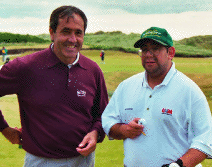
During his trip to Ireland for the World Special Olympics, John Espinoza had the opportunity to meet World Golf Hall of Fame member Seve Ballesteros.
At the time, the trip to Myrtle Beach seemed like a once-in-a-lifetime opportunity. It wasn't. Since then, John has played golf at courses too numerous to name. But his biggest trip came this past June when John, a five-time gold medallist in golf at the Montana Special Olympics State Games, represented the United States at the 2003 Special Olympics World Summer Games in Dublin. John played five days of fiercely competitive golf on Portmarnock's challenging Bernard Langer-designed links. On a course guarded by deep pot bunkers and lined with deep fescues, John led the field for much of the event. Holding the lead going into the final holes of the last day, John struggled at the finish but finished third in the world. John's family and friends are ecstatic about his bronze medal.
His dad says, "(Playing in the world games) gave him something to work for and made him responsible for achieving it, and his dreams came true." John, ever the competitor, now knows he can play the game with anyone. When he goes to a golf course, he approaches the first tee with a swagger.
John demonstrated his confidence while we played together in the Peaks and Prairies GCSA tournament in 2002. The first time I golfed with John three years ago at my own facility, I remember he was somewhat unsure of himself. But playing in John's group at this tournament, I was the uptight one, and John was ready to swing. As the other players on our scramble team apprehensively met John, I was nervous about how the round would go. One of our teammates was a 30-something board member from a local club. He looked like he wanted to be anywhere but with us on our par-3 starting hole. When the siren sounded, John practically sprinted to the tee. His ball arched beautifully to the center of the green. After everyone picked their jaws off the turf and hit their own shots, John's ball was the only one on the green.
Two holes later, John, wanting to strike up a conversation, casually strolled up to the aloof young board member while we waited for the fairway to clear. John asked the young businessman, "Do you like watching WWF?" A funny grin appeared on the man's face and he said to John, "I never miss it." Then he and John struck up a 45-minute conversation about their favorite wrestling characters. They were inseparable for the rest of the event and talked about everything from girlfriends to hunting.
It is hard not to be drawn to John.
Army of superintendents
Superintendents and golf course maintenance operations continue to be a primary support network for John's GC. Quietly, they look after the course's needs but prefer no recognition. This is a seemingly normal trait for superintendents, who are used to working without notoriety. Steve credits superintendents for an amazing show of support and for the power of their networking abilities. Steve says, "We wouldn't exist without the team of superintendents and the GCSAA."
Bruce Williams, CGCS at Los Angeles Country Club, is a good example of Steve's support team. Williams, a 27-year member and 1996 GCSAA president, first encountered the Espinozas when John's GC was in its infancy. Steve, originally from the Los Angeles area, was visiting family in California, including a relative who was a gardener at LACC. Williams, after learning about Steve's project, told him to help himself to the course's scrap pile. Since then, the "scrap pile" donations have evolved considerably. Los Angeles CC, like several other generous donors, has become a major source of support for John's GC.
Williams says, "It's as worthy of a cause as I've been a part of. The proof is in the pudding. Nothing beats the reward of seeing a smile on John's face." After several years of involvement, the Espinozas and Williams have become like extended family.
"That's the way it is with Steve," Williams says. "You get back more than you give. Usually with a charitable donation, you give, feel good and that is the end of it. With Steve, he makes you personally involved. He calls you back. He sends you pictures. He sends you e-mails. He stops by to see you when he's in town. He tells you about John's newest accomplishments. Nobody has a hands-on touch like that. Steve's excitement and energy boils over."
Williams says people are drawn to the Espinozas' project and moved to help because the story is heartwarming and because they get personally involved with the story. On one of his recent trips to LACC, Steve produced an ice chest. He pulled what Williams describes as a "very large frozen trout" and with it, a note. The note was to Williams from a child back in Eureka who wrote that he and his dad wanted to catch Williams a large fish to thank him for helping John so much, but the child apologized for just getting one "little" fish.
The involvement from Steve's quiet army of superintendents is important. The first rule of John's GC has always been: We do it with no money. Steve says, "We don't have funds, so we go to 'alternative methods.'" This usually involves piecing together donated equipment and parts to produce something functional. His local logger friends are very handy mechanics who have a knack for making almost anything work. Most of Steve's equipment is lackluster, but if he or his friends can get it to work, he is happy with it. If he has other needs, he trades and barters for it.
Not all of the equipment at John's GC is lacking spit and polish. After contacting Club Car Inc. to try to find some used golf cars, Steve soon found himself with a Solorider golf car straight off the showroom floor along with several other cars. Club Car has since taken a similar personal involvement to John's GC as many superintendents. Many other suppliers have joined the cause as well. Rainbird provides regular irrigation donations, and the Wilbur Ellis Co. gives fertilizer and fungicide. Eureka-area plumbing suppliers frequently pitch in along with many other local businesses.
'It only gets better'
Despite all the positive things that continue to happen for John's GC, occasionally Steve gets discouraged. He suffers from many of the same frustrations that superintendents face. Equipment breaks. He can't get needed parts. He doesn't have the right equipment for a job. The hours are long and the work is hard. Steve is always trying to improve the rough edges of his facility, but he sometimes loses patience for the snail's pace progress makes at a nonprofit backyard golf course. When Steve starts getting down, his usually quiet wife steps in.
"This is part of the story behind John's Golf Course. It isn't just about the successes. It is also about the hardship," Juana says. "The course does not have to be perfect. Things are not always going to function. This is John's Golf Course, and this is what we are about."
People generally assume that they are only helping the Espinozas with donations to John's GC, but they are also helping the disabled, elderly, children and people who can't afford golf to experience the sport. For example, a family from Canada travels to Eureka to play golf because they don't have the money to teach their three kids golf at another facility. So, they bring them to the Espinoza's course to play with John. Another visitor is a paraplegic who plays the facility courtesy of the donated Club Car Solorider. This individual had been unable to experience golf since being confined to a wheelchair.
"That's who we reach out to," Steve says of the golfers at his course who don't have other outlets or opportunities that can cater to their special needs.
Of course, John's GC welcomes golfers without special needs, too. You just need to be ready to play a round with John, and I can assure you that you'll enjoy it.
If you ask Steve where the course is going from here, he says, "It only gets better!" If you want to contact the Espinoza family, Steve welcomes your calls. You can reach John's GC at (406) 889-3685. |
|
|





